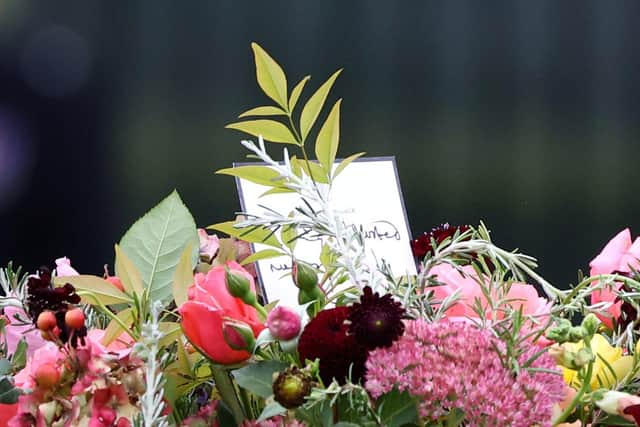Queen Elizabeth II funeral: Service began with choral beauty and ended with a lone piper's lament
As the coffin of Queen Elizabeth II paused on the threshold of Westminster Abbey, the congregation of 2,000 people, including some of the world’s most powerful political leaders, rose to their feet.
The choir of Westminster Abbey sang the Sentences, lines of scripture set to music, as the procession made its way slowly and steadily between the rows of onlookers.
Advertisement
Hide AdAdvertisement
Hide Ad

The soaring voices were later joined by the choir of the Chapel Royal, St James's Palace, to spine-tingling effect.
The coffin, draped in the Royal Standard and with the Imperial State Crown and a wreath of flowers laid upon it, had arrived outside the abbey at 10:53am.
Shortly before, the organ music inside had halted.
The sound of bagpipes and the roll and clatter of drums could be heard, faintly at first, as the procession began its journey from Westminster Hall.
Inside, the murmur of conversation was replaced by silence and the occasional whisper.
The doors of Westminster Abbey, which has witnessed every coronation since 1066 and where the air is thick with history, had been open from 8am, with the general congregation arriving before political leaders and other prominent figures followed.
Rarely has so much power gathered in one building. It is impossible to comprehend the headache it must have caused for the police and security services.
US president Joe Biden entered shortly after 10am, holding hands with his wife, Jill. He sat 14 rows back on the south transept, with Realm governor generals and Commonwealth countries taking precedent in front.
Liz Truss, the new Prime Minister, who met the Queen at Balmoral just two days before she died and who later read a lesson at the funeral, followed around 15 minutes later.
Advertisement
Hide AdAdvertisement
Hide AdSenior politicians and former prime ministers were joined by foreign dignitaries and luminaries from all walks of life. Striking military uniforms, festooned with medals, added splashes of colour to the sea of dark suits and dresses.
Among the royals were Prince George, the nine-year-old future king, and his seven-year-old sister Princess Charlotte, who walked behind the Queen’s coffin as part of the solemn procession through the gothic church.
Flanked by their parents, the Prince and Princess of Wales, the two youngsters walked a little behind King Charles and Camilla, Queen Consort, and ahead of the Duke and Duchess of Sussex.
Others couldn’t quite believe they had been invited to share in this moment.
Walter Cunningham Peyton Smith, from Largs, received a telephone call – with no caller ID – from the Cabinet Office last Saturday afternoon. His invitation arrived on Saturday morning by special delivery.
“I was flabbergasted when the call came,” the 75-year-old said. “I’m not normally a speechless person, as you can imagine.”
Mr Smith, the former chair of the Prince’s Trust Ayrshire, received an MBE earlier this year for services to youth enterprise and education.
He described it as a “great honour” to attend the funeral.
Security around the abbey was predictably tight, with guests navigating three layers of checks, including airport-style scanners. They had been asked to bring two forms of identification and no hand luggage.
Advertisement
Hide AdAdvertisement
Hide AdRoads around Westminster Abbey were closed off, with a heavy police presence and armed officers lining the route.
It was the first time in 262 years the abbey had staged a monarch’s funeral, and the scale and grandeur of the occasion was unparalleled. It took the breath away.
But there were personal touches, too.
The new King, who looked visibly emotional as the national anthem was sung, had left a handwritten message on the Queen’s coffin. “In loving and devoted memory. Charles R,” it read, a simple, but poignant detail.
Among the hymns were The Lord’s My Shepherd, which was sung at the Queen’s wedding to Prince Philip at the abbey in 1947. It would be just a few years after this happy moment that Elizabeth II would first feel the weight of the crown upon her head, following the death of her father, George VI.
The Archbishop of Canterbury, the Most Reverend Justin Welby, quoted from the Queen’s broadcast during the dark days of the Covid lockdown.
"We will meet again,” she had said, evoking lyrics from Dame Vera Lynn’s wartime song to powerful effect.
All who followed the Queen’s example can say this with her, the archbishop added.
This was a ceremony underpinned by a deep Christian faith, as well as a sense of service and duty.
Advertisement
Hide AdAdvertisement
Hide Ad"People of loving service are rare in any walk of life,” the archbishop earlier told the congregation. “Leaders of loving service are still rarer.
"But in all cases, those who serve will be loved and remembered when those who cling to power and privileges are forgotten.”
O Taste and See, written by Ralph Vaughan Williams for the Queen’s coronation in the abbey in 1953, provided another moment of profound choral beauty.
Later, as the choir performed a new anthem written for the service by Scottish composer Sir James McMillan, their voices seemed to fill the entire space, rising up to the abbey’s ornate roof before gently ebbing away.
After the Last Post, sounded by the State Trumpeters of the Household Cavalry from the steps of the Lady Chapel, came the two minutes’ silence. Every cough and shuffle of the feet was magnified to booming volume by the stillness.
Pipe Major Paul Burns, the Queen’s Piper, helped close the funeral with a rendition of the traditional piece Sleep, Dearie, Sleep, before the coffin left Westminster Abbey for Windsor.
It was a last lament for a monarch who treasured Scotland, its wild landscapes and her time at Balmoral – a place where, in the words of her granddaughter Princess Eugenie, she was “most happy”.
Comments
Want to join the conversation? Please or to comment on this article.

